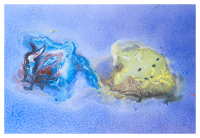Conveners
Parallel V: F5 Nuclear and Astroparticle Physics
- Andreas Schmitt (TU Vienna)
David Blaschke
(University of Wroclaw)
11/09/2014, 16:30
Section F: Nuclear and Astroparticle Physics
We aim at clarifying three of the fundamental puzzles related to the still unsolved problem of the structure of the dense core of compact stars (CS): (i) hyperon puzzle: how to reconcile pulsar masses of 2M$_\odot$ with the hyperon softening of the equation of state (EoS); (ii) masquerade problem: modern EoS for cold, high density hadronic and quark matter are almost identical; and (iii)...
David Edwin Alvarez Castillo
(JINR)
11/09/2014, 16:50
Section F: Nuclear and Astroparticle Physics
In order to prove the existence of a critical end point (CEP) in the
QCD phase diagram it is sufficient to demonstrate that at zero
temperature $T=0$ a first order phase transition exists as a function
of the baryochemical potential $\mu$, since it is established
knowledge from ab-initio lattice QCD simulations that at $\mu=0$ the
transition on the temperature axis is a crossover.
We...
Stefan Schramm
(Goethe University)
11/09/2014, 17:10
Section F: Nuclear and Astroparticle Physics
Phenomenological approaches to Quantum Chromodynamics covering the region from low to high temperature and/or density have to address the problem that the effective degrees of freedom change drastically from hadrons to quarks and gluons.
We study this situation with a unified description of hadronic and quark matter allowing for cross-over as well as first or second-order phase transitions....
Alessandro Drago
(University of Ferrara)
11/09/2014, 17:50
Section F: Nuclear and Astroparticle Physics
I will show that Delta resonances are easily produced in compact stars when the asymmetry energy is taken into account by using the correct value of its density derivative at saturation (the parameter called L). The Delta production has crucial implications on the maximum mass of the compact stars and on their radius.
Mr
Aleksei Ivanov
(SPBSPU & PNPI)
11/09/2014, 18:10
Section F: Nuclear and Astroparticle Physics
Hadron and lepton production in hard interaction of high-energy particles with nuclei are considered in context of developing of Monte Carlo generator HARDPING (Hard Probe Interaction Generator). Such effects as energy losses and multiple re-scattering initial and produced hadrons and their constituents are taken into account. These effects are implemented in the current version of generator...
